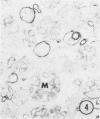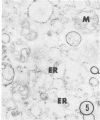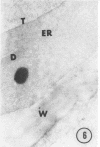Abstract
Tissue, homogenates, and purified cell fractions prepared from hypocotyls of a dicot, soybean (Glycine max), and meristematic tissue of a monocot, onion (Allium cepa), were examined critically for evidence of adenylate cyclase activity. Three assay methods were used: chemical analysis, isotope dilution analysis, and enzyme cytochemistry. In both crude extracts or whole tissue, as well as purified membranes, with or without auxin, no adenylate cyclase was detected by any of the three methods.
For plasma membranes, the specific activity was less than 1/40 or 1/25,000 that of rat liver plasma membranes, depending on the assay procedure, i.e. below the limits of detection. Using comparable methods, we could detect neither cyclic adenosine 3′:5′-monophosphate nor the phosphodiesterase responsible for its degradation in either purified membranes or homogenates. The results suggest that hormone responses in plants are not generally mediated by a mechanism involving the obligate production of cyclic adenosine 3′:5′-monophosphate by a plasma membrane associated adenylate cyclase.
Full text
PDF





Images in this article
Selected References
These references are in PubMed. This may not be the complete list of references from this article.
- Bressan R. A., Ross C. W. Attempts to detect cyclic adenosine 3':5'-monophosphate in higher plants by three assay methods. Plant Physiol. 1976 Jan;57(1):29–37. doi: 10.1104/pp.57.1.29. [DOI] [PMC free article] [PubMed] [Google Scholar]
- Cutler L. S., Rossomando E. F. Localization of adenylate cyclase in Dictyostelium discoideum. II. Cytochemical studies on whole cells and isolated plasma membrane vesicles. Exp Cell Res. 1975 Oct 1;95(1):79–87. doi: 10.1016/0014-4827(75)90611-4. [DOI] [PubMed] [Google Scholar]
- Giannattasio M., Carratu G., Tucci G. F. Presence of a cyclic-AMP-binding protein in Jerusalem artichoke rhizome tissues. FEBS Lett. 1974 Dec 15;49(2):249–253. doi: 10.1016/0014-5793(74)80523-5. [DOI] [PubMed] [Google Scholar]
- Howell S. L., Whitfield M. Cytochemical localization of adenyl cyclase activity in rat islets of Langerhans. J Histochem Cytochem. 1972 Nov;20(11):873–879. doi: 10.1177/20.11.873. [DOI] [PubMed] [Google Scholar]
- Keates R. A. Cyclic nucleotide-independent protein kinase from pea shoots. Biochem Biophys Res Commun. 1973 Sep 18;54(2):655–661. doi: 10.1016/0006-291x(73)91473-3. [DOI] [PubMed] [Google Scholar]
- Krishna G., Weiss B., Brodie B. B. A simple, sensitive method for the assay of adenyl cyclase. J Pharmacol Exp Ther. 1968 Oct;163(2):379–385. [PubMed] [Google Scholar]
- LOWRY O. H., ROSEBROUGH N. J., FARR A. L., RANDALL R. J. Protein measurement with the Folin phenol reagent. J Biol Chem. 1951 Nov;193(1):265–275. [PubMed] [Google Scholar]
- Lin P. P. Cyclic nucleotides in higher plants? Adv Cyclic Nucleotide Res. 1974;4(0):439–460. [PubMed] [Google Scholar]
- Pohl S. L., Birnbaumer L., Rodbell M. Glucagon-sensitive adenyl cylase in plasma membrane of hepatic parenchymal cells. Science. 1969 May 2;164(3879):566–567. doi: 10.1126/science.164.3879.566. [DOI] [PubMed] [Google Scholar]
- Pollard C. J. Rapid gibberellin responses and the action of adenosine 3',5'-monophosphate in aleurone layers. Biochim Biophys Acta. 1971 Dec 21;252(3):553–560. doi: 10.1016/0304-4165(71)90158-9. [DOI] [PubMed] [Google Scholar]
- Ralph R. K., McCombs P. J., Tener G., Wojcik S. J. Evidence for modification of protein phosphorylation by cytokinins. Biochem J. 1972 Dec;130(4):901–911. doi: 10.1042/bj1300901a. [DOI] [PMC free article] [PubMed] [Google Scholar]
- Rodbell M. Metabolism of isolated fat cells. V. Preparation of "ghosts" and their properties; adenyl cyclase and other enzymes. J Biol Chem. 1967 Dec 25;242(24):5744–5750. [PubMed] [Google Scholar]
- Roland J. C., Lembi C. A., Morré D. J. Phosphotungstic acid-chromic acid as a selective electron-dense stain for plasma membranes of plant cells. Stain Technol. 1972 Jul;47(4):195–200. doi: 10.3109/10520297209116484. [DOI] [PubMed] [Google Scholar]
- Spurr A. R. A low-viscosity epoxy resin embedding medium for electron microscopy. J Ultrastruct Res. 1969 Jan;26(1):31–43. doi: 10.1016/s0022-5320(69)90033-1. [DOI] [PubMed] [Google Scholar]
- Sutherland E. W. Studies on the mechanism of hormone action. Science. 1972 Aug 4;177(4047):401–408. doi: 10.1126/science.177.4047.401. [DOI] [PubMed] [Google Scholar]
- Van Der Woude W. J., Lembi C. A., Morré D. J. beta-Glucan Synthetases of Plasma Membrane and Golgi Apparatus from Onion Stem. Plant Physiol. 1974 Sep;54(3):333–340. doi: 10.1104/pp.54.3.333. [DOI] [PMC free article] [PubMed] [Google Scholar]
- Vandepeute J., Huffaker R. C., Alvarez R. Cyclic nucleotide phosphodiesterase activity in barley seeds. Plant Physiol. 1973 Sep;52(3):278–282. doi: 10.1104/pp.52.3.278. [DOI] [PMC free article] [PubMed] [Google Scholar]
- Wood H. N., Lin M. C., Braun A. C. The inhibition of plant and animal adenosine 3':5'-cyclic monophosphate phosphodiesterases by a cell-division-promoting substance from tissues of higher plant species. Proc Natl Acad Sci U S A. 1972 Feb;69(2):403–406. doi: 10.1073/pnas.69.2.403. [DOI] [PMC free article] [PubMed] [Google Scholar]










